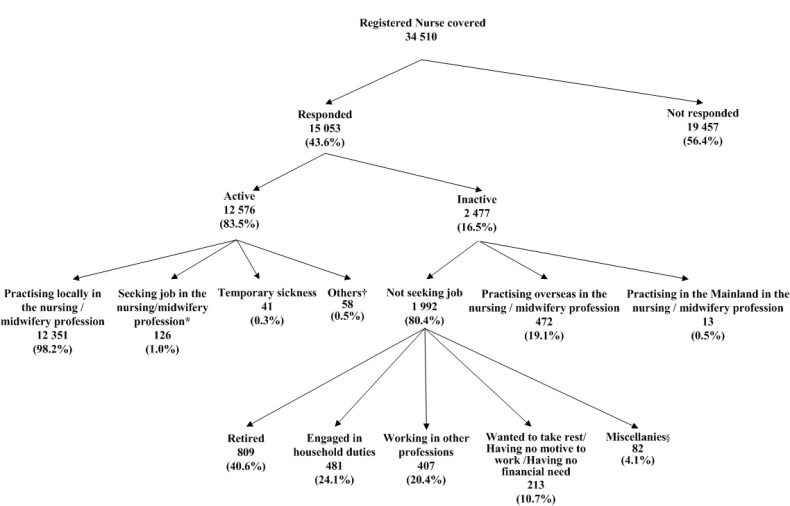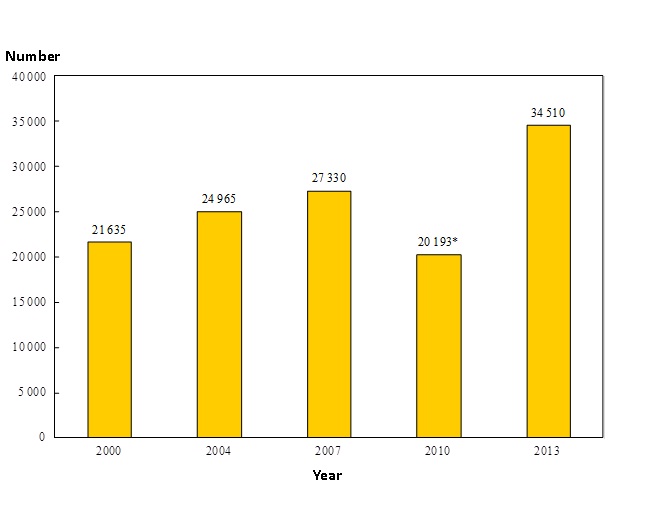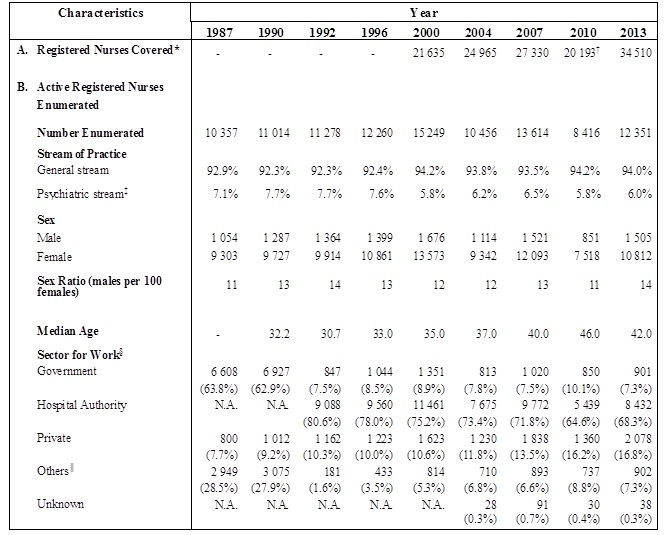Statistics
2013 Health Manpower Survey
Summary of the Characteristics of Registered Nurse Enumerated
I. Registered Nurses Covered
1.1 The registered nurses covered in the 2013 HMS were nursing personnel registered in the register under the Nurses Registration Ordinance (Chapter 164) as at the survey reference date - 31.8.2013.
1.2 The number of registered nurses covered was 34 510.
1.3 Of the 34 510 registered nurses covered, 15 053 responded to the survey, giving an overall response rate of 43.6%. Among the respondents, 12 576 (83.5%) were economically active*† (active) in the local nursing / midwifery profession as at 31.8.2013 and 2 477 (16.5%) reported that they were economically inactive*‡ (inactive) in the local nursing / midwifery profession (Chart A) .
1.4 Of the 12 576 active registered nurses enumerated, 126 were seeking jobs in the local nursing / midwifery profession during the 30 days before the survey, 41 had not been available for work because of temporary sickness and 58 believed that work was not available, were waiting to take up a new job, expecting to return to their original jobs or starting business at subsequent date in the local nursing / midwifery profession during the 30 days before the survey. The survey results presented in paragraph 1.6 below were based on 12 351 responding registered nurses who were practising in the local nursing / midwifery profession as at 31.8.2013. As certain questionnaires contained missing information, percentages presented below may not add up to 100% .
1.5 Of the 2 477 inactive registered nurses, 472 reported practising overseas, 13 reported practising in the Mainland and 1 992 reported not seeking job in the local nursing / midwifery profession during the 30 days before the survey (Chart A). Among the 1 992 inactive registered nurses who reported not seeking jobs, the main reasons reported for not seeking jobs included: 809 (40.6%) were retired, 481 (24.1%) were engaged in household duties, 407 (20.4%) were working in other professions and 213 (10.7%) wanted to take a rest / had no motive to work / had no financial need, etc.
* In the survey, the criteria used in defining economically active / inactive followed those recommended by the International Labour Organization, which are also being used by the Census and Statistics Department in Hong Kong.
† "Economically active" registered nurses comprised all "employed" and "unemployed" registered nurses. "Employed" registered nurses referred to those registered nurses practising in the nursing / midwifery profession in Hong Kong during the survey period, while "unemployed" registered nurses referred to those registered nurses who (a) were not practising in the local nursing / midwifery profession during the survey period; (b) had been available for work during the seven days before the survey; and (c) had sought work in the local nursing/midwifery profession during the 30 days before the survey.
‡ "Economically inactive" registered nurses comprised the registered nurses who were not practising in the nursing / midwifery profession in Hong Kong during the survey period, excluding those who had been on leave during the survey period and who were "economically active" but "unemployed".
Chart A : Activity Status of Registered Nurses Covered

|
Note:
|
* | Figure refers to the number of responding registered nurses who (a) were not practising in the nursing / midwifery profession in Hong Kong during the survey period; (b) had been available for work during the seven days before the survey; and (c) had sought work in the nursing / midwifery profession during the 30 days before the survey. Figure refers to the number of responding doctors who (a) were not practising in the medical profession in Hong Kong during the survey period; (b) had been available for work during the seven days before the survey and (c) had sought work in the local medical profession during the 30 days before the survey. |
| † | Figure refers to the number of responding registered nurses who (a) were not practising in the nursing / midwifery profession in Hong Kong during the survey period; (b) had been available for work during the seven days before the survey; and (c) believed that work was not available, were waiting to take up a new job, expecting to return to their original jobs or starting business at subsequent date in the local nursing / midwifery profession during the 30 days before the survey. | |
| ‡ | Figure refers to the number of responding registered nurses who reported emigrated, undertaking study, etc. | |
| Percentage may not add up to 100% due to rounding. |
1.6 Among the 12 351 active registered nurses enumerated who were practising in the local nursing / midwifery profession, 11 616 (94.0%) were in the general stream and 735 (6.0%) were in the psychiatric stream*.
1.7 There were 34 active registered nurses who did not indicate their sex. Among the remaining 12 317 active registered nurses enumerated who were practising in the local nursing / midwifery profession, 1 505 (12.2%) were male and 10 812 (87.8%) were female, giving an overall sex ratio (males per 100 females) of 13.9. Apart from 379 registered nurses who did not indicate age, the median age of the remaining 11 972 active registered nurses enumerated was 42.0 years. The median age of the active female registered nurses enumerated was 42.0 years and that of their male counterparts was 39.0 years.
1.8 The responding active registered nurses were requested to indicate the characteristics of their main jobs†. Distribution by sector for the main job showed that more than half (68.3%) of the active registered nurses enumerated were working in the Hospital Authority, followed by those working in the private sector (16.8%), the academic and subvented sectors (7.3%) and the Government (7.3%).
1.9 The median age of the active registered nurses enumerated was 49.0 years for those working in the Government, followed by 48.0 years for those working in the academic and subvented sectors, 42.0 years in the private sector and 40.0 years in the Hospital Authority.
1.10 Of the 12 351 active registered nurses enumerated, 19.4% spent most of their working time on medicine, followed by 14.7% on surgery, 7.1% on ambulatory care / outpatients, 6.7% on paediatrics, 6.7% on geriatrics, 6.6% on administration / management, 5.7% on obstetrics, 5.6% on public health and 5.5% on mental health / psychiatric / addiction treatment.
1.11 The median number of hours of work (excluding meal breaks) per week of the 12 351 active registered nurses enumerated was 44.0 hours. Among them, 1 081 (8.8%) were required to undertake on-call duty, with median number of 14.0 hours of on-call duty (excluding normal duty) per week.
1.12 Of the 12 351 active registered nurses enumerated, 58.9% had Student / Pupil Nurse Training, 24.7% held Bachelor’s degree and 12.4% held Higher Diploma as their basic qualifications.
1.13 Of the 12 351 active registered nurses enumerated, 10 215 (82.7%) received / were receiving additional training. Of the 10 215 active registered nurses with additional training, 203 (2.0%) had not yet completed the additional training, 4 114 (40.3%) held Bachelor’s Degree, 3 194 ( 31.3% ) held Master’s Degree, 1 148 (11.2%) held Certificate, 568 (5.6%) held Diploma and 423 (4.1%) held Post-graduate Diploma as the highest qualification.
* Figure includes one registered nurse (sick children).
† Main jobs refer to the jobs in which the registered nurses have spent most of their working time
1.14 Among those registered nurses who received / were receiving additional training, some of them selected more than one field of additional training. The total number of count of active registered nurses who received / were receiving additional training was 18 371, in which 13.3% received / were receiving additional training in midwifery, 10.4% in general nursing, 5.3% in intensive care nursing, 5.2 % in emergency / first aid nursing, 5.0% in geriatric nursing, 4.6% in nursing administration. 4.5% in community health, 4.4% in public health nursing and 4.0 % in surgical nursing.
1.15 Of the 10 215 registered nurses who received / were receiving additional training, 5 504 (53.9%) were trained / receiving training in one field. Among them, 16.8% were trained / receiving training in general nursing, 14.2% in midwifery, 4.9% in emergency / first aid nursing, 4.7% in intensive care nursing, 4.6% for each field in public health nursing and surgical nursing, 4.5% in geriatric nursing and 4.1% in mental health nursing.
1.16 Regarding Continuing Nursing Education (CNE) / Post-registration Education in Midwifery (PEM) activities, 10 914 (88.4%) of the active registered nurses reported that they had participated in CNE / PEM activities in 2013, 1 271 (10.3%) had not participated in any CNE / PEM activities in 2013 and 166 (1.3%) did not report whether they had participated in CNE / PEM activities or not. Among the 10 914 active registered nurses enumerated who had participated in CNE / PEM activities, the distribution of CNE / PEM points / hours attained in the past 12 months was: 1 to 5 points / hours (10.7%), 6 to 10 points / hours (11.7%), 11 to 15 points / hours (16.6%), 16 to 20 points / hours (14.3%) and more than 20 points / hours (46.6%).
II. Trend Analysis
2.1 Comparison of findings of the 2013 HMS with those surveys before 2004 should be cautious as the survey methodology and reference date had been changed.
2.2 Between 2000 and 2013, the number of registered nurses covered was in the range from 20 193 to 34 510. The proportion of registered nurses in the general stream remained stable (92.3% - 94.2%) between 1987 and 2013 (Chart B & Table A).
Chart B : Number of Registered Nurses Covered by Year (2000, 2004, 2007, 2010 and 2013)

| Note: | * | As the 2010 Health Manpower Survey only aimed at covering all registered nurses who had to renew their practising certificates in 2010, registered nurses who did not need to renew practising certificates in 2010 were excluded from the survey. |
| Figure of 2000 refers to the number of registered nurses registered with Nursing Council of Hong Kong and who were holding valid practising certificates issued by the Nursing Council of Hong Kong as at the 1st of July 2000, whereas the figures of 2004 to 2007 and 2013 refer to the number of registered nurses as at the 31st of August of the respective years and the figure of 2010 refers to that as at 31st of August 2010 and had to renew their practising certificates in 2010. |
2.3 The sex ratio (males per 100 females) of active registered nurses enumerated ranged from 11 to 14 between 1987 and 2013 (Table A).
2.4 The median age of the active registered nurses enumerated increased from 32.2 years in 1990 to 42.0 years in 2013.
2.5 From 1987 to 1990, the largest proportion of active registered nurses enumerated was working in the Government, which accounted for about 60% and the remaining registered nurses worked in the private, academic and subvented sectors. Since its setup in 1991, the Hospital Authority has been the largest employer covering 68.3% of active registered nurses in 2013, while the proportion of active registered nurses employed in the Government was about 7%. The proportion of active registered nurses working in the private sector increased from 10.0% in 1996 to 16.8% in 2013. During the same period, the proportion of active registered nurses working in the academic and subvented sectors increased from 3.5% to 7.3% (Table A).
Table A : Selected Characteristics of Active Registered Nurses Enumerated (1987, 1990, 1992, 1996, 2000, 2004, 2007, 2010 and 2013)

|
Note:
|
* | Figure of 2000 refers to the number of registered nurses registered with Nursing Council of Hong Kong and who were holding valid practising certificates issued by the Nursing Council of Hong Kong as at the 1st of July 2000, whereas the figures of 2004, 2007 and 2013 refer to the number of registered nurses as at the 31st of August of the respective years and the figure of 2010 refers to that as at 31st of August 2010 and had to renew their practising certificates in 2010. |
| † | As the 2010 Health Manpower Survey only aimed at covering all registered nurses who had to renew their practising certificates in 2010, registered nurses who did not need to renew practising certificates in 2010 were excluded from the survey. | |
| ‡ | Figure may include registered nurses (sick children) and registered nurses (mentally subnormal). | |
| § | In 2004, 2007, 2010 and 2013, the sector refers to the sector for the main job. | |
| ║ | In 2004, 2007, 2010 and 2013, the sector refers to the sector for the main job. | |
| There may be slight discrepancy between the sum of individual items and the total due to rounding. | ||
| N.A. Not applicable. | ||
| ‘ - ’ Not available. |